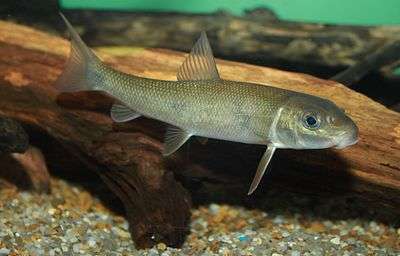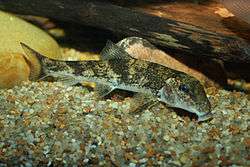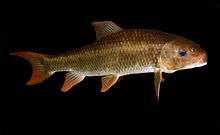Catostomidae
The Catostomidae are the suckers of the order Cypriniformes, with about 78 species in this family of freshwater fishes. The Catostomidae are almost exclusively native to North America. The only exceptions are Catostomus catostomus, found in both North America and Russia, and Myxocyprinus asiaticus found only in China. In the Ozarks they are a common food fish and a festival is held each year to celebrate them.[1] Ictiobus cyprinellus can reach an age up to 112 years, making it the oldest known freshwater teleost.[2]
| Catostomidae | |
|---|---|
 | |
| White sucker, Catostomus commersonii | |
| Scientific classification | |
| Kingdom: | |
| Phylum: | |
| Class: | |
| Order: | |
| Suborder: | |
| Family: | Catostomidae Cope, 1871 |
| Genera | |
|
See text | |
Description and biology
The mouth of this fish is located on the underside of its head (subterminal), with thick, fleshy lips. Most species are less than 60 cm (2.0 ft) in length, but the largest species (Ictiobus and Myxocyprinus) can surpass 100 cm (3.3 ft). They are distinguished from related fish by having a long pharyngeal bone in the throat, containing a single row of teeth.[3]
Catostomids are most often found in rivers, but can be found in any freshwater environment. Their food ranges from detritus and bottom-dwelling organisms (such as crustaceans and worms), to surface insects, crayfish, small terrestrial vertebrates, and other fish.
Fossil record
Catostomidae have been uncovered and dated to the Middle Eocene in Colorado and Utah. An enormous gap (36.2 million years) in the fossil record occurs from the Late Eocene to Early Pleistocene.[4]
As food

They can be taken by many fishing methods, including angling and gigging. Often, species such as Catostomus commersonii and Hypentelium nigricans are preferred for eating. They can be canned, smoked, or fried, but small incisions often must be made in the flesh (termed "scoring") before frying to allow small internal bones to be palatable.[5] Suckers were an important source of food for Indigenous Americans across the continent. Many fishing methods were employed with the most elaborate being stone fish traps constructed on spawning rivers, remnants of these traps can be seen today in Ahjumawi Lava Springs State Park where the Achomawi people trapped Sacramento suckers. In the west these relationships became even more important after the decline in salmon runs due to damming and habitat destruction, some groups of native people relied on seasonal sucker runs for a significant amount of their food until the 1950s.[6]
In China there is a significant aquaculture industry dedicated to raising Myxocyprinus asiaticus for food.[7] Historically they were an important component of wild fisheries on the Yangtze, but the wild populations are under pressure from pollution, habitat destruction and hydroelectric dam projects.[8]
Recreational fishing
Some Catostomidae, especially those of Ictiobus and Moxostoma, are the subject of major recreational fisheries while most are the subject of at least limited recreational fisheries. Throughout much of their range species are considered to be rough fish. Suckers have historically been scapegoated for human environmental destruction and their impacts on popular fish species such as Pacific salmon and smallmouth bass. This has led to their widespread and unnecessary destruction at the hands of ignorant anglers.[9]
Subfamilies, tribes, and genera


- Subfamily Catostominae
- Tribe Catostomini
- Genus Catostomus
- Genus Chasmistes
- Genus Deltistes
- Genus Xyrauchen
- Tribe Erimyzoninae
- Genus Erimyzon
- Genus Minytrema
- Tribe Thoburniinae
- Genus Hypentelium
- Genus Thoburnia
- Tribe Moxostomatini
- Genus Moxostoma
- Tribe Catostomini
- Subfamily Cycleptinae
- Genus Cycleptus
- Subfamily Ictiobinae
- Subfamily Myxocyprininae
- Genus Myxocyprinus
- other extinct genera
- Genus †Jianghanichthys
- Genus †Plesiomyxocyprinus
- Genus †Vasnetzovia
References
- "Nixa Sucker Day". Retrieved 23 June 2013.
- Lackmann, Alec R.; Andrews, Allen H.; Butler, Malcolm G.; Bielak-Lackmann, Ewelina S.; Clark, Mark E. (2019-05-23). "Bigmouth Buffalo Ictiobus cyprinellus sets freshwater teleost record as improved age analysis reveals centenarian longevity". Communications Biology. 2 (1): 197. doi:10.1038/s42003-019-0452-0. ISSN 2399-3642. PMC 6533251. PMID 31149641.
- Banister, Keith F. (1998). Paxton, J.R.; Eschmeyer, W.N. (eds.). Encyclopedia of Fishes. San Diego: Academic Press. p. 100. ISBN 978-0-12-547665-2.
- Paleobiology database.
- "Night Hawk Publications - John's Journal".
- "Subsistence Fishing For Sacramento Sucker". fishbio.com. fishbio.com. Retrieved 22 April 2019.
- Lin, Y.; Y. Gong; Y. Yuan; S. Gong; D. Yu; Q. Li; and Z. Luo (2012). Dietary L-lysine requirement of juvenile Chinese sucker, Myxocyprinus asiaticus. Aquaculture Research, 44(10): 1539–1549. doi:10.1111/j.1365-2109.2012.03161.x
- Koga, James S. Chinese high fin banded shark, Cal Poly Pomona, September 2003. Retrieved on 5 May 2019
- Miller, Matthew L. "A Sucker (Myth) Is Born Every Minute". blog.nature.org. Nature. Retrieved 2 May 2019.
- Froese, Rainer, and Daniel Pauly, eds. (2011). "Catostomidae" in FishBase. August 2011 version.
- Bruner, John Clay (1991). "Comments on the genus Amyzon (family Catostomidae)". Journal of Paleontology. 65 (4): 678–686. doi:10.1017/s0022336000030766. JSTOR 1305679.
| Wikimedia Commons has media related to Catostomidae. |